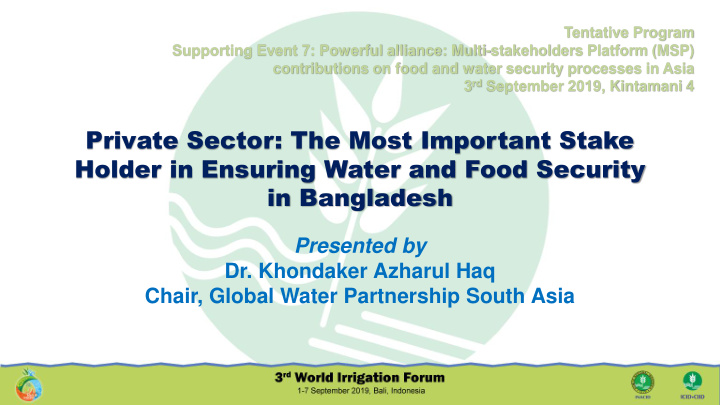



Tentative Program Supporting Event 7: Powerful alliance: Multi-stakeholders Platform (MSP) contributions on food and water security processes in Asia 3 rd September 2019, Kintamani 4 Private Sector: The Most Important Stake Holder in Ensuring Water and Food Security in Bangladesh Presented by Dr. Khondaker Azharul Haq Chair, Global Water Partnership South Asia
Location of Bangladesh in South Asia
General Information • Total Area: 143,998 sq km Land Area: 130,168 sq km Water Area: 13,830 sq km • Population: 168 million (2017) • Population Density 988 per sq km • Average rain fall: 2000 mm maximum of 5,690 mm in the northeast of the country to minimum of 1,110 mm in the west • Average temperature: 26.1 ° C (79 ° F) • Literacy rate: 65% (2017) • GDP: 6.5% (2017)
Bangladesh Climate Graph
Agricultural Statistics • Cultivable land: 8.44 million ha • Current fellow: 0.469 million ha • Major Crops: Paddy, Jute, Sugarcane, Wheat, Potato • Cropping intensity: 200%(Approx.)in 2017 154% in 1980 • Average Yield: Paddy 3 t/ha Wheat 2 t/ha • Irrigated Land: 7 million ha in 2017 0.94 million ha at 1972
FEW BASIC Statistics • Contribution of Agriculture to GDP – 16.4% • Population dependent on agriculture – 60% • Total cereal requirement: 32 million M. tons • Total cereal production: 33 million M. tons
Private Sector Participation Year Investment in Irrigation Equipment by the Private Sector Area Irrigated by Private Sector operated Irrigation 2017 Equipment: 7.4Mha Total Agricultural Area/Land: 10 Mha (Approx.) Number of Irrigation Equipment Operated by Private Sector: 1.6M (Approx.) Capital Investment by the Private Sector (in USD$): 1.6M *500 = 800 Million (Approx.)
Other Bene Other Benefits fits fr from P om Priva rivate te Sect Sector P or Par articip ticipation in tion in Irriga Ir rigation: tion: 1. Local manufacture of irrigation equipment 2. Creation of over 1.6M irrigation entrepreneurs 3. Government saved 800 Million USD$ from investment 4. Establishment of other support industries like pipe, engine pump and other accessories manufactures
Use of Irrigation Engines in Sectors other than Agricultures • In river boats • In rural transportation • In transporting goods and agriculture produce • In threshing paddy and milling rice etc.
Private Sector Led Irrigation Expansion Ensures Food Security: • Rapid irrigation expansion • Withdrawal of ground water regulation • Withdrawal of Standardization of Irrigation equipment • Privatization of Irrigation equipment • Privatization of Fertilizer market • Introduction of HYV seeds and privatization of seed market • Cereal production in 1971: 10.5 MMT • Cereal production in 2017: 33 MMT
Constraints, Challenges & Opportunities • Per unit Area yield (t/ha) is very low • Water Productivity (kg/m3) very low • Yield gap between research station and farmer’s field very high • Ground water table is depleting at a faster rate threatening of sustainability of irrigation • Availability of surface water is diminishing by the day • Arsenic contamination has introduced a new challenge to food security • Evidence of nitrate and pesticides build up in ground water. • Agriculture sector uses 80% of the available water but is a very inefficient user of water • Climate change will pause even a bigger threat water, food and livelihood security
Role of GWP • GWP has been instrumental in introducing IWRM Concept for sustainable and environment friendly agricultural development • GoB in its 6 th Five year development plan indicated “An enabling environment has been created for IWRM. The program and projects of water sector in the 6 th plan would be guided on the back drop of this favorable environment” • GWP should strengthen its catalytic role in the improved and sustainable management of water resources, agricultural production system etc. • GWP can act as independent evaluator to very claims of governments on food security issues and achieving SDG goals
Strategic Partners in the MSP • Ministries of Water Resources, Agriculture, Environment and Forest • Water Resources Planning Organization (WARPO), Center for Environmental and Geographic Information Services (CEGIS), Bangladesh Water Development Board (BWDB), Local Government Engineering Department (LGED), National and International Agricultural Research System, GWP/BWP Area Water Partnerships (AWPs), Institute of Water Modelling (IWM) and NGOs/INGOs and most importantly the PRIVATE SECTOR
Future Action Agenda • Help identify strengths and especially weakness for sustainable growth of agricultural production system • Help with water security issues with especial emphasis in trans- boundary rivers by providing a platform for basin wide tract – II initiatives for improving food and environmental security. • Help launch an aggressive awareness campaign for conservation of water and other related resources for food security • Breaking the double digit barrier in rice yield per unit area per year
THANK THANK YOU OU
Recommend
More recommend